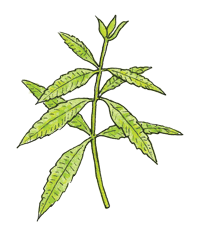Lemon Verbena

A perennial herb in zones 9 and 10, lemon verbena can be grown as an annual in northern climates. It forms a shrubby plant that benefits from regular pruning to keep it from getting leggy. Fortunately, regular trimming also gives you plenty of citrusy leaves for use in beverages and dishes. Try steeping leaves in hot water, and then enjoy the resulting tea hot or cold. You can also mince the leaves and use them to flavor fish and vegetable dishes.
The easiest way to grow lemon verbena is to start with a small plant. (Although it's possible to grow it from seed, it's challenging to start and slow to grow.) Lemon verbena prefers full sun and free-draining soil that has been amended with compost. Heavy clay or overly wet soils will cause the roots to rot. Plant it near the edge of the bed where you'll be apt to brush by the foliage, causing the leaves to release some of their lemony scent.
Lemon verbena can be a bit finicky and will respond to stress by dropping its leaves. Don't give up too quickly on the plant, however, because it may produce more leaves. Some gardeners overwinter their lemon verbena indoors by withholding water late in the outdoor growing season, triggering the plant to enter dormancy, and then bringing it indoors. Other gardeners simply start with fresh plants each spring.
Last updated: 06/23/2022
Print this Article:
Get the Dirt
Stay up to date on new articles and advice. Please fill out the information below.
